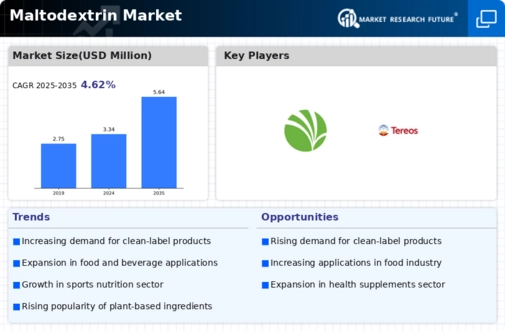Maltodextrin Size
Maltodextrin Market Growth Projections and Opportunities
The Maltodextrin market is influenced by a myriad of factors that collectively shape its dynamics and growth trajectory. One of the primary drivers of this market is the widespread application of maltodextrin in the food and beverage industry as a versatile and cost-effective ingredient. Maltodextrin, derived from starch, serves various functions such as a thickener, filler, or stabilizer in a wide range of food products, contributing to its popularity among manufacturers for enhancing texture and mouthfeel. The multifunctional nature of maltodextrin makes it a key ingredient in the formulation of processed foods, beverages, and nutritional products.
Changing consumer dietary patterns and the demand for convenience foods also play a significant role in shaping the Maltodextrin market. As lifestyles become busier, consumers seek convenient and ready-to-eat food options. Maltodextrin, with its ability to improve the texture and shelf stability of processed foods, is widely used in convenience products like instant soups, sauces, and snacks. This aligns with the growing preference for on-the-go and easily preparable food items, contributing to the sustained demand for maltodextrin.
The impact of the sports nutrition and functional food trends is another notable factor influencing the Maltodextrin market. Maltodextrin is commonly used in sports drinks and energy bars as a quick source of carbohydrates for athletes and fitness enthusiasts. Its rapid digestion and absorption make it an ideal ingredient for replenishing glycogen stores during and after physical activity. The increasing emphasis on health and wellness, coupled with the popularity of sports nutrition products, contributes to the growth of maltodextrin consumption.
Technological advancements in food processing and the development of modified forms of maltodextrin contribute to the market's evolution. Modified maltodextrins, such as resistant maltodextrin, are designed to have specific functional properties, including resistance to digestion in the small intestine. This innovation opens new possibilities for incorporating maltodextrin into products catering to consumers seeking low-calorie or low-glycemic index options, aligning with the demand for healthier food choices.
The influence of clean-label and natural ingredients trends is impacting the Maltodextrin market. As consumers become more conscious of the ingredients in their food and beverages, there is a growing demand for clean-label alternatives. Maltodextrin manufacturers are responding by offering organic and non-GMO (genetically modified organism) options, meeting the preferences of consumers who seek natural and transparent ingredient lists in the products they consume.
Economic factors, including raw material prices and production costs, play a significant role in the Maltodextrin market. Maltodextrin is primarily derived from starch sources such as corn, wheat, or tapioca. Fluctuations in the prices of these raw materials can impact the overall production cost of maltodextrin, influencing pricing and profitability for both manufacturers and consumers. Market players must navigate these economic considerations to maintain competitive pricing and ensure the stability of their supply chains.
The impact of global food trends and cultural influences shapes the demand for maltodextrin in various regions. In some cultures, maltodextrin is used in traditional culinary applications, contributing to the regional variations in consumption patterns. Additionally, the globalization of food preferences has led to an increased adoption of maltodextrin in diverse cuisines and food products worldwide.
The influence of sustainability considerations is gaining importance in the Maltodextrin market. Consumers are increasingly concerned about the environmental impact of food production and packaging. Maltodextrin manufacturers are responding by exploring sustainable sourcing practices, eco-friendly packaging solutions, and reducing their carbon footprint to align with the growing demand for environmentally conscious products.



 Source: Secondary Research, Primary Research, Market Research Future Database and Analyst Review
Source: Secondary Research, Primary Research, Market Research Future Database and Analyst Review


Leave a Comment